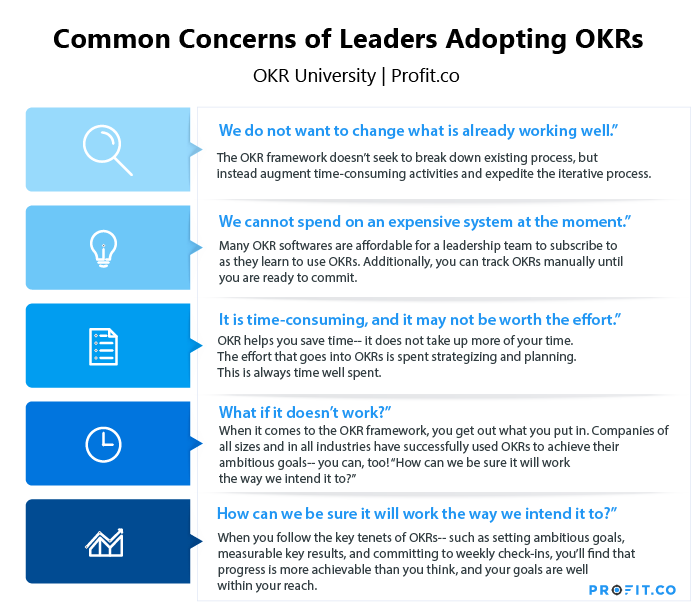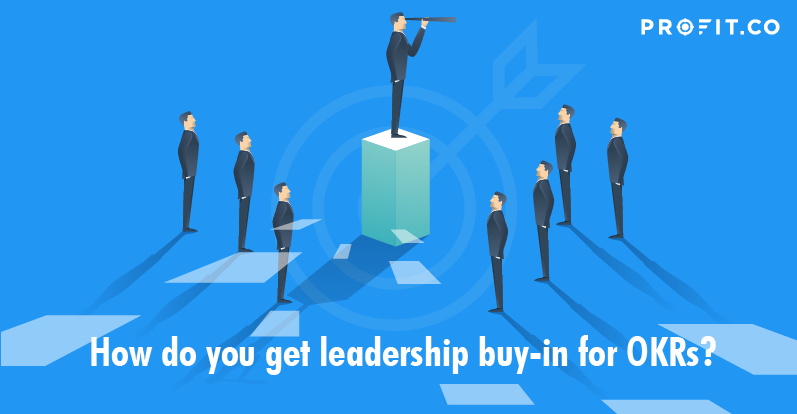Getting leadership buy-in for your OKR program is a vital part of succeeding with this framework. Unless the leaders of your organization believe in the effectiveness of the process and are able to encourage their subordinates about the possibilities of the framework, OKRs very likely will not work well for your organization.
In this article, we’ll review how you can get leadership buy-in for your OKRs.
How can you address their concerns?
Objectives and Key Results is a goal-setting framework that inspires employees to aim high and achieve more. It allows their participation when it comes to goal setting, especially when they set their team goals.
Good leaders must communicate vision clearly, creatively, and continually.
However, the leadership team plays a crucial role in setting the objectives for the organization and creating an agenda for the teams.

So, implementing Objectives and Key Results starts with a top-down approach from the leadership team. Once implemented, OKR does not necessarily get adopted naturally by the employees of an organization. The leaders need to work hard to make the employees integrate OKR into the work culture.
For that, the company leadership needs to be convinced in the first place that OKR can transform the organization and power the progress of the organization towards its vision. Only when there is leadership buy-in, the employees start embracing OKR as their goal-setting framework.
To manage your OKR program on agile and intuitive software, look no further than Profit.co! You can start your free trial with Profit.co today!
How does leadership buy-in of OKR benefit all levels of the organization?
Leadership buy-in drives far and wide adoption of the OKR goal-setting framework in the organization and offers specific benefits to all the levels in the organization.
- Executives can set the agenda in line with the vision, mission, and core values of the organization, and trigger rapid adoption of objectives across the organization by achieving alignment. It helps them formulate and execute strategies better and faster. When there is clarity of purpose at the top level, it flows to all the levels.
- Managers can set their priorities and action plans in line with the bigger objectives using OKR. They can create transparency and accountability, allocate resources better and create synergies with other teams.
- Individuals get to see a clear picture of how their work translates into positive outcomes for the organization. This inspires them and gives meaning and purpose to their work. It provides clarity on what is expected out of them.
Executives can regularly track long-term progress, as teams deliver outcomes that move the organization towards its objectives week after week. They can cultivate a data-driven high performance culture and improve the collaboration amongst teams.
Leadership buy-in of OKR is the first and foremost step that triggers adoption by the employees and makes all the aforementioned benefits of OKRs possible for the organization.
Ready to start your OKR Journey for FREE?
How does leadership buy-in impact OKR success?
Leaders are the most influential people in an organization. If they do not approve or show interest in a program or initiative, it will fail due to various factors ranging from lack of ownership from the employees to inadequate resource allocation. So, when implementing Objectives and Key Results in an organization, leadership buy-in is indispensable for its success. Leaders can impact OKR adoption across the organization in many ways.
- They are in charge of strategy and direction. So, only if they kickstart goal setting and strategy implementation using OKR at the organization level, the next logical steps of goal setting at the team and individual levels happen in quick succession.
- They have more say and influence in the organization. They can take forward the OKR adoption, reach out to the employees and influence them. They can direct team leaders and managers to use OKRs for goal setting. They can appoint experts for OKR coaching.
- They have more reach, as they have the power to write/speak to every employee of the organization at any time on any topic, using various channels of communication. They can engage with employees, communicate how the employees can use OKRs to excel in their profession, and celebrate achievements with employees, to drive adoption.
- Once they kickstart the use of OKR, leaders have the ability to turn goal-setting into a bottom-up process, by inviting feedback and participation from team leaders and members, and encouraging them to set their own ambitious goals. By listening to feedback from teams and tweaking the organization’s OKRs based on that, leaders can also inspire and empower the employees.
- OKR inspires organizations to aim higher than what is possible. So, even 70% achievement is considered a success. By allowing employees the room to fall short, they’ll set even more ambitious goals and most likely surprise themselves with what they achieve.
- When there is leadership buy-in, employees take OKRs seriously as a part of their work life.
What are the common concerns of the leaders in adopting OKR?
Leadership buy-in is easier said than done. The leadership team has so many functions, and they have different priorities. They seek stability, and radical changes are not easily accepted. Objectives and Key Results drastically change the way goals are set and how objectives are fulfilled in an organization.
It fundamentally changes the collective mindset of the workforce and impacts the culture of the organization. Provided the room for such a far-reaching, powerful impact that OKRs can have in the organization, if not implemented right, it can potentially cause problems. So, naturally, the leaders do not readily accept the OKR framework. Following are some of the arguments they usually come up with, when they are asked to implement OKR in their organization.

1. “We do not want to change what is already working well.”
Every organization sets goals and works towards them in some way. But aligning people, setting the right goals, and focusing on the right things at all levels requires a strong goal-setting framework. Even if the current goal-setting process works, it does not prepare the organization for the challenges of tomorrow and future-proof the business.
Also, following the same system while scaling the operations may not necessarily yield similar good results. OKR enables agility, scalability, and adaptability to external conditions, by driving quick alignment and making every employee work towards the objectives of the organization with focus, commitment, and participation.
2. “We cannot spend on an expensive system at the moment.”
A good goal-setting framework pushes employees in the right direction, creates alignment, and makes the employees at all levels work towards a common purpose. It enables exponential growth, and hence, investing in OKR applications will pay dividends sooner than later. However, if there is still reluctance, it is possible to implement OKR without getting a software suite. Goals can be set and shared across the organization on a spreadsheet using email.
To learn about Profit.co’s affordable and powerful OKR software, schedule a free demo with our OKR experts!
3. “It is time consuming, and it may not be worth the effort and time commitment.”
Implementing any change requires some time, and OKR is no exception. But the benefits of OKR outweigh the risks. It makes employees perform better, innovate and deliver outcomes that push the organization towards its objectives faster. It promotes alignment, coordination, and teamwork.
4. “What if it doesn’t work?”
It has worked for top companies around the world, including Google, HP, Linkedin, etc. It is a proven framework. With proper guidance and OKR coaching by experts, it can be implemented properly. If employees are trained on how to set their goals and achieve them, there is no reason for Objectives and Key Results to fail in your organization.
5. “How can we be sure it will work in the way we intend it to work?”
OKR works on the principle of setting specific, measurable goals and working towards them. Every goal is accompanied by indicators that denote progress against the goals. So, it is easy to track the progress through weekly check-ins, quickly identify issues, and put a performance on track effectively within a short period of time.

